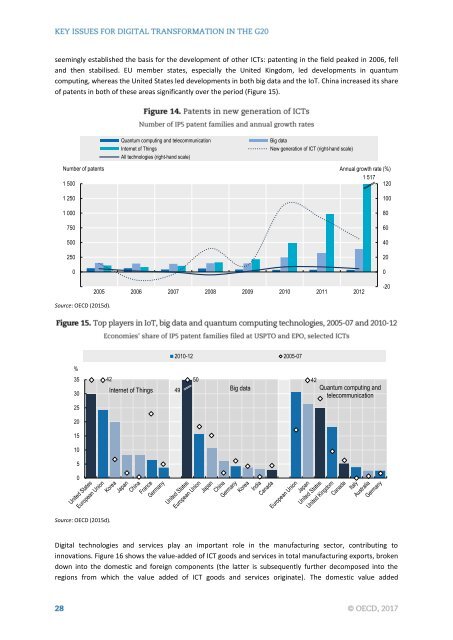KEY ISSUES FOR DIGITAL TRANSFORMATION IN THE G20
2jz0oUm
2jz0oUm
Create successful ePaper yourself
Turn your PDF publications into a flip-book with our unique Google optimized e-Paper software.
seemingly established the basis for the development of other ICTs: patenting in the field peaked in 2006, fell<br />
and then stabilised. EU member states, especially the United Kingdom, led developments in quantum<br />
computing, whereas the United States led developments in both big data and the IoT. China increased its share<br />
of patents in both of these areas significantly over the period (Figure 15).<br />
Quantum computing and telecommunication<br />
Internet of Things<br />
All technologies (right-hand scale)<br />
Big data<br />
New generation of ICT (right-hand scale)<br />
Number of patents<br />
1 500<br />
1 250<br />
1 000<br />
750<br />
500<br />
250<br />
0<br />
Annual growth rate (%)<br />
1 517<br />
120<br />
100<br />
80<br />
60<br />
40<br />
20<br />
0<br />
250<br />
2005 2006 2007 2008 2009 2010 2011 2012<br />
-20<br />
Source: OECD (2015d).<br />
2010-12 2005-07<br />
%<br />
35<br />
30<br />
25<br />
42 50 42<br />
Internet of Things 49<br />
Big data<br />
Quantum computing and<br />
telecommunication<br />
20<br />
15<br />
10<br />
5<br />
0<br />
Source: OECD (2015d).<br />
Digital technologies and services play an important role in the manufacturing sector, contributing to<br />
innovations. Figure 16 shows the value-added of ICT goods and services in total manufacturing exports, broken<br />
down into the domestic and foreign components (the latter is subsequently further decomposed into the<br />
regions from which the value added of ICT goods and services originate). The domestic value added


